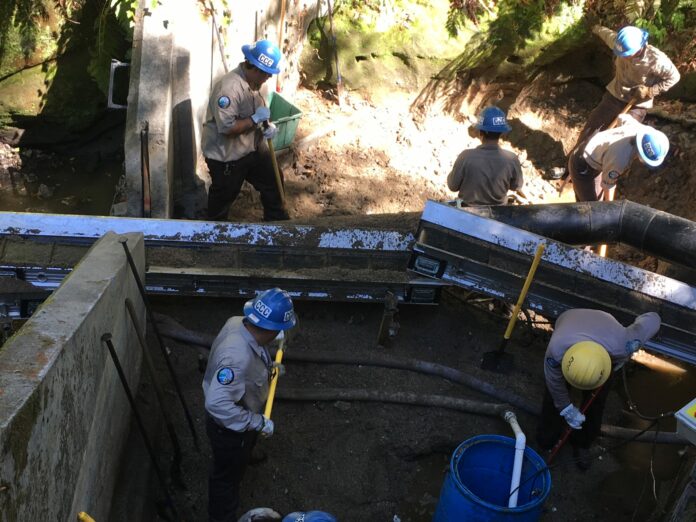After almost two weeks of work, the Fall Creek Fish Ladder is finally almost cleared of several feet-deep debris, caused by the storms of 2016 and 2017.
The San Lorenzo Valley Water District, with assistance from the California Conservation Corps (CCCs), started to remove debris from the fish ladder early last week. According to Environmental Programs Manager at the SLVWD, Jen Michelsen, this is just Phase I of improving the Fall Creek Fish Ladder.
“This is really critical habitat for steelhead,” Michelsen said. “Fall Creek is great for steelhead spawning because there is no development upstream in the State Park.”
During the past winter storms rock and sediment filled the fish ladder, impairing fish passage. After extensive surveying and permitting, the district was allowed to work with CCCs and remove the debris by shovel and other hand tools, passing the materials down stream using a conveyor belt. In an effort to improve habitat, the debris removed from the fish ladder will be moved downstream to be redistributed during the winter high stream flows.
While the debris is being removed, the District temporarily diverted the water flow out of the ladder. According to Michelsen, the excess debris amounts to approximately 30 cubic yards. The survey on steelhead population in Fall Creek is not published yet, so there is no way to tell for certain what impact the debris in the fish ladder has had so far, according to Michelsen.
“Normally when we are doing monitoring there are a lot of juvenile steelhead in the fish ladder,” Michelsen said. “But when there is a lot of sediment and no pools in the fish ladder, there have not been a lot of steelhead.”
Since the District took over the fish ladder in 2008, there has not been an issue of excess debris until 2017, however with climate change and the uncertainty of storm damage, this will likely happen again in the future, Michelsen said. The total cost for the debris removal is estimated at approximately $50,000, with 75 percent of the funding coming from FEMA.
But this is just Phase I of II to improve the Fall Creek Fish Ladder. According to Michelsen, Phase II, which will hopefully start next July, will involve improving jump heights in the ladder. Currently, some of the jumps are too high for the fish to get over. After the improvements planned in Phase II, jump heights will be six inches, allowing fish at all stages of life to get over the ladder. Since Phase II will be a more extensive project, requiring the maximum allotted time to work in the stream, it was vital the District clean the debris from the ladder this fall.
“The Water District is trying to take care of the environment throughout this whole process,” Michelsen said. “We are trying to be good stewards of our watershed.”













